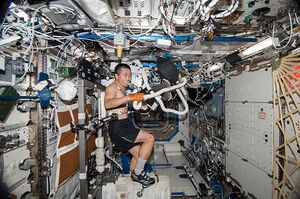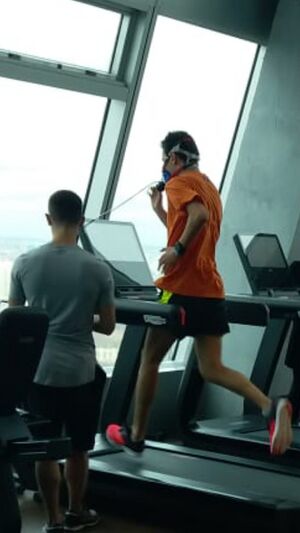VO2 Max: Difference between revisions
No edit summary |
No edit summary |
||
| Line 5: | Line 5: | ||
</div> | </div> | ||
== Introduction == | == Introduction == | ||
[[File: | [[File:VO 2 max.jpeg|right|frameless]] | ||
VO2 max calculates how efficiently your cells use oxygen for energy. | VO2 max testing is the gold standard or most accurate test of [[Aerobic Exercise|aerobic]] or [[Cardiovascular System|cardiovascular]] fitness. VO2 max calculates how efficiently your cells use oxygen for energy.<ref name=":0">Bundy M, Leaver A. [https://www.sciencedirect.com/topics/medicine-and-dentistry/vo2-max A Guide to Sports and Injury Management E-Book.] Elsevier Health Sciences; 2012 Aug 12.Available: https://www.sciencedirect.com/topics/medicine-and-dentistry/vo2-max<nowiki/>(accessed 27.11.2021)</ref>. This is an excellent measure of physical fitness because it provides a metric of efficiency. | ||
'''Image 1: :''' JAXA astronaut Koichi Wakata, Expedition 38 flight engineer, performs a VO2max session. | |||
'''Image | '''Image 2:''' Athlete during the vo2 max test in the Biohacking Laboratory | ||
== Testing == | == Testing == | ||
[[File:Vo2max test.jpeg|right|frameless]] | |||
The testing procedure is not readily available as it requires the athlete's ventilation to be measured very accurately with the concentrations of oxygen and carbon dioxide of inspired and expired air being measured while the athlete performs the graded exercise test on a treadmill or static bike. An athlete's VO2 max is reached when their oxygen uptake remains constant even though the intensity of the exercise test increases. It is measured in litres/minute (L/min) or millilitres/minute per kilogram (mL/min/kg) of body weight. <ref name=":0" /> | The testing procedure is not readily available as it requires the athlete's ventilation to be measured very accurately with the concentrations of oxygen and carbon dioxide of inspired and expired air being measured while the athlete performs the graded exercise test on a treadmill or static bike. An athlete's VO2 max is reached when their oxygen uptake remains constant even though the intensity of the exercise test increases. It is measured in litres/minute (L/min) or millilitres/minute per kilogram (mL/min/kg) of body weight. <ref name=":0" /> | ||
Revision as of 02:16, 28 November 2021
Original Editor - Lucinda hampton
Top Contributors - Lucinda hampton, Mandeepa Kumawat and Kim Jackson
Introduction[edit | edit source]
VO2 max testing is the gold standard or most accurate test of aerobic or cardiovascular fitness. VO2 max calculates how efficiently your cells use oxygen for energy.[1]. This is an excellent measure of physical fitness because it provides a metric of efficiency.
Image 1: : JAXA astronaut Koichi Wakata, Expedition 38 flight engineer, performs a VO2max session.
Image 2: Athlete during the vo2 max test in the Biohacking Laboratory
Testing[edit | edit source]
The testing procedure is not readily available as it requires the athlete's ventilation to be measured very accurately with the concentrations of oxygen and carbon dioxide of inspired and expired air being measured while the athlete performs the graded exercise test on a treadmill or static bike. An athlete's VO2 max is reached when their oxygen uptake remains constant even though the intensity of the exercise test increases. It is measured in litres/minute (L/min) or millilitres/minute per kilogram (mL/min/kg) of body weight. [1]
The above test can be difficult to administer and are not suitable for all fitness levels. The simplest formula to calculate VO2 max is VO2 max = 15 x (HRmax/HRrest). This method is considered to compare well with other common formulas. The units for VO2 max are milliliters of oxygen per kilogram of body weight per minute (mL/kg/min).[2]
VO2 Max Ranges[edit | edit source]
VO2 max ranges will depend on a variety of factors, such as the person's age and gender.
- For 20 to 29-year-old males, the range is about 46 to 62.
- For males between the ages of 50 and 59, the range is about 32 to 49.
- For women between the ages of 20 and 29, VO2 max is usually around 43 and
- Women who are 50 to 59 years old generally have a VO2 between 29 and 39.
As these numbers demonstrate, age and gender play a significant role in an individual's VO2 max[3].
VO2 - Not the whole story[edit | edit source]
Aerobic exercise improves V02 max significantly. Interestingly, much of this improvement results from an increase in the size of the heart. So clearly, V02 max is a great measure of physical fitness. But it is a poor predictor of athletic performance. If you measured the V02 max of eight world-class cyclists before a race, you would be hard pressed to predict which of them would win if you only had their respective V02 max values. This is where the lactate threshold comes into the picture. Lactate threshold is defined as the intensity of exercise at which lactate begins to accumulate in the blood at a faster rate than it can be removed.[4]
Heritability of VO2 Max[edit | edit source]
The heritability of VO2max is 0.43 to 0.72, which means that genetic factors account for 43-72% of the difference in values between individuals.
Activity and fitness level will also affect an individual’s VO2max value. A trained individual will have a higher VO2max than an untrained person, and values will also vary depending on the mode of Exercise.[5]
Although the VO2max has a significant genetic component and is affected by the aging process, it can improve significantly at any age with regular endurance training by approximately 15–20% or 0.5.l/min, depending on exercise intensity, in healthy sedentary/recreationally active humans. Accordingly, it is possible that a trained 70-year-old can exhibit the biological age of an untrained 50-year-old based on the VO2max, which declines at about 7% (women) to 10% (men) per decade from the age of around 25 years, but in an endurance-trained person starting from a higher level[6]
Elite endurance athletes have a high .VO(2,max) due primarily to a high cardiac output from a large compliant cardiac chamber (including the myocardium and pericardium) which relaxes quickly and fills to a large end-diastolic volume. This large capacity for LV filling and ejection allows preservation of blood pressure during extraordinary rates of muscle blood flow and oxygen transport which support high rates of sustained oxidative metabolism. The magnitude and mechanisms of cardiac phenotype plasticity remain uncertain, probably involving underlying genetic factors, as well as the length, duration, type, intensity and age of initiation of the training stimulus.[7]
A study exploring factors that may be related to ethnic differences in the maximum rate at which an individual can consume oxygen (VO2max) between 20 African American (AA) and 30 European American (EA) sedentary women who were matched for body weight (kg) and fat-free mass (FFM). Mitochondrial muscle oxidative capacity and oxygen delivery capabilities accounted for most if not all of the ethnic differences in VO2max[8].
Longetivity[edit | edit source]
CRF (VO2max) is the strongest independent predictor of future life expectancy in both healthy and cardiorespiratory-diseased individuals.
Age-related physiological adaptations occurring with regular exercise training, with specific reference to the main organs (lung, heart, skeletal muscles) involved in oxygen delivery and utilization as well as the importance of exercise training is essential for improving life expectancy. It is not possible to extend the genetically fixed lifespan with regular exercise training, but it possible give the years more life by changes that occur with an improved VO2 max.[6]
Sub Heading 3[edit | edit source]
Resources[edit | edit source]
- bulleted list
- x
or
- numbered list
- x
References[edit | edit source]
- ↑ 1.0 1.1 Bundy M, Leaver A. A Guide to Sports and Injury Management E-Book. Elsevier Health Sciences; 2012 Aug 12.Available: https://www.sciencedirect.com/topics/medicine-and-dentistry/vo2-max(accessed 27.11.2021)
- ↑ Wikihow How to Measure VO2 Max Available: https://www.wikihow.com/Measure-VO2-Max (accessed 27.11.2021)
- ↑ Livestrong How to Calculate Your VO2 Max for Cycling https://www.livestrong.com/article/461725-how-to-calculate-your-vo2-max-for-cycling/ (accessed 27.11.2021)
- ↑ Active Lactate Threshold and V02 Max Explained Available:https://www.active.com/triathlon/articles/lactate-threshold-and-v02-max-explained (accessed 27.11.2021)
- ↑ Aozata VO2 Max-> How to calculate? Available: https://www.aozata.com/vo2-max-how-to-calculate/(accessed 27.11.2021)
- ↑ 6.0 6.1 Strasser B, Burtscher M. Survival of the fittest: VO2max, a key predictor of longevity. Front Biosci (Landmark Ed). 2018 Mar 1;23(23):1505-16.Available:https://www.fbscience.com/Landmark/articles/10.2741/4657 (accessed 28.11.2021)
- ↑ Levine BD. : what do we know, and what do we still need to know?. The Journal of physiology. 2008 Jan 1;586(1):25-34.Available:https://pubmed.ncbi.nlm.nih.gov/18006574/ (accessed 27.11.2021)
- ↑ Roy JL, Hunter GR, Fernandez JR, McCarthy JP, Larson‐Meyer DE, Blaudeau TE, Newcomer BR. Cardiovascular factors explain genetic background differences in VO2max. American Journal of Human Biology: The Official Journal of the Human Biology Association. 2006 Jul;18(4):454-60.Available: https://pubmed.ncbi.nlm.nih.gov/16788902/ (accessed 27.11.2021)








